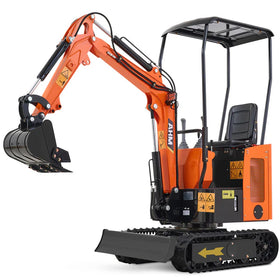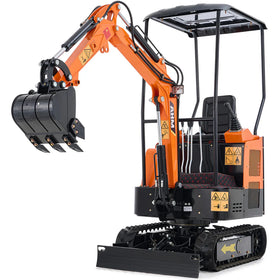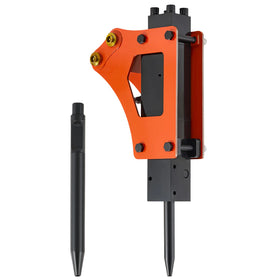If you've ever felt your mini excavator wobble or tilt unexpectedly, you're dealing with a stability issue that could be dangerous. As someone who's operated these machines for over 15 years, I can tell you that understanding how weight affects your excavator is crucial for safety.
Lesser Known Facts About Mini Excavator Stability

Mini excavators stay balanced because of their counterweight design.
The cab and engine serve as counterweights to the boom, arm, and bucket when digging. This balance point—called the center of gravity—must stay within the excavator's track footprint for the machine to remain stable.
When your excavator feels unstable, it usually means the center of gravity has shifted too far outside the track footprint. This happens most often when:
- The boom is extended too far
- You're working on a slope
- The load in your bucket is too heavy
- The tracks aren't properly positioned
Common Causes of Instability in Mini Excavators

1. Working on Uneven Ground
The most common reason operators experience tipping problems is working on slopes or uneven terrain.
Even a 15-degree slope can reduce your excavator's stability by up to 30%.
Before starting work, use your bucket and blade to level the ground where possible, especially for your tracks. This creates a more stable platform.
2. Overloading the Bucket
Your mini excavator's manual lists maximum load capacities. Exceeding these limits is like trying to carry too many groceries at once—you'll lose balance.
How much is too much?
A typical 1-ton mini excavator can safely handle about 500 pounds in its bucket when the arm is partially extended. This capacity drops significantly as you extend the arm further.
Further Reading: How Much Weight Can A Mini Excavator Lift
3. Extending the Boom Too Far
The further you extend your boom and arm, the more leverage the weight has to tip your machine. It's like holding a heavy weight close to your body versus holding it at arm's length.
Safety practice: Keep the load as close to the excavator as practical. When you must reach out, reduce your load accordingly.
4. Improper Track Positioning
Your tracks should always be fully extended when lifting or digging. Some operators narrow the tracks to fit through tight spaces but forget to widen them again before operating.
Warning Signs Your Mini Excavator Might Tip Over
Don't wait until it's too late. Here are the warning signs experienced operators watch for:
- The excavator feels "light" on one side - If one track feels like it's losing contact with the ground, stop immediately
- Unusual resistance in controls - When hydraulics struggle against gravity, controls may feel different
- Creaking or unusual noises - Metal under stress makes distinctive sounds before failure
- Visible tilt beyond normal operation - If you can see the machine tilting more than usual, you're in the danger zone
- Track spinning or slipping - When a track loses ground contact, it may spin freely
How to Fix Weight Distribution Problems
If you notice any warning signs, take these immediate steps:
- Lower the bucket to the ground - This immediately lowers your center of gravity
- Retract the boom slowly - Bring the weight closer to the machine's center
- Never swing toward the downhill side - This compounds instability
- Reposition the excavator - Move to more level ground if possible
Preventative Measures That Keep Your Compact Excavator Stable
Based on my experience working with hundreds of operators, these practices prevent most stability problems:
1. Check Ground Conditions First
Before unloading your excavator at a site, walk the area to check for:
- Soft spots that could collapse
- Hidden slopes that aren't obvious
- Underground utilities that limit where you can position
- Proper drainage (wet soil reduces stability)
2. Use Outriggers When Available
Some mini excavators have deployable outriggers. Always use them when:
- Lifting heavy loads
- Working on anything but flat ground
- Doing precision work that requires extended reach
3. Never Exceed Manufacturer Specifications
The load chart in your operator's manual isn't a suggestion—it's a safety requirement based on engineering calculations. Many operators keep a laminated copy in their cab for quick reference.
Safety Checklist for Mini Excavator Operators
Print this checklist and keep it in your excavator:
- ☐ Tracks fully extended for operation
- ☐ Ground properly compacted and level
- ☐ Load within specified weight limits
- ☐ Boom extended appropriate distance for load weight
- ☐ Machine positioned perpendicular to slopes when possible
- ☐ Counterweight positioned uphill when working on slopes
- ☐ Load kept as close to machine as practical
- ☐ Regular maintenance of tracks and hydraulics completed
When to Call a Professional
Some situations require expert intervention:
- When you must work on slopes greater than 15 degrees
- When loads exceed 75% of your machine's maximum capacity
- When ground conditions are questionable (recent rain, backfilled areas)
- When your excavator shows signs of hydraulic problems affecting stability
Conclusion

Experience across many job sites has shown that tipping incidents often occur when we're in a hurry or have become accustomed to routine operations. Even the most skilled operators benefit from maintaining a healthy respect for the unchanging laws of physics that govern these powerful machines.
Taking just a few minutes to assess your position and load before beginning work creates a foundation for both safety and productivity. This small investment of time can prevent accidents that might result in project delays or, most importantly, protect everyone's wellbeing on the job site.







